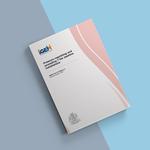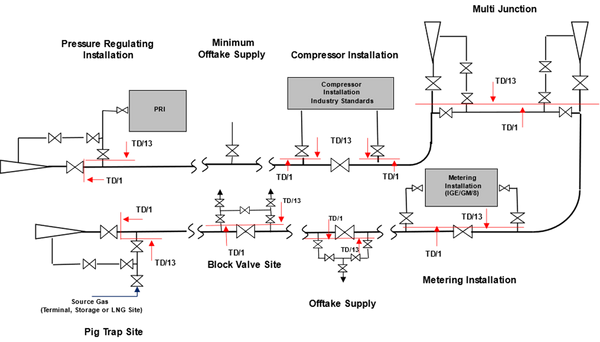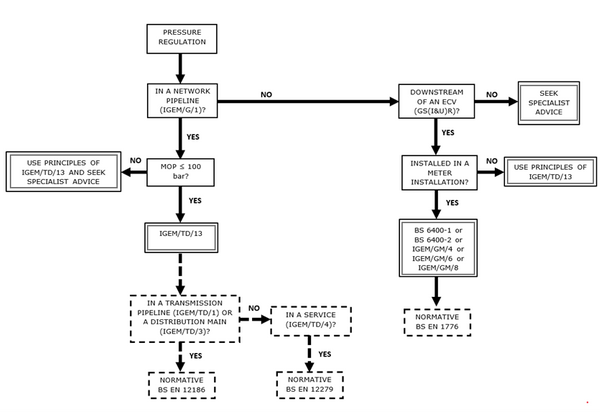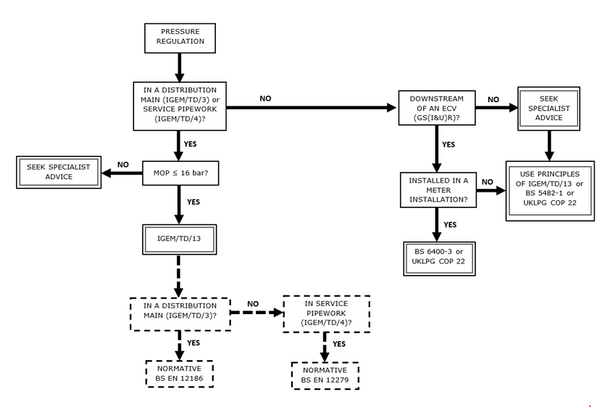IGEM/TD/13 Edition 3 Pressure regulating and exceeding 7 bar pipeline installations

This Standard applies to the safe design, construction, inspection, testing, operation and maintenance, decommissioning, and disposal of pressure regulating installations (PRIs) not exceeding 100 bar and exceeding 7 bar pipeline installations.
It covers any PRI or >7 bar pipeline installation containing; natural gas that is installed in a network pipeline and where the maximum operating pressure does not exceed 100 bar at operating temperatures between -20°C and 120°C. Liquefied Petroleum Gas (LPG) that is installed in either a distribution main or service pipework and whose maximum operating pressure does not exceed 16 bar at operating temperatures between -20°C and 50°C. LPG/air mixture that is installed in either a distribution main or service pipework and whose maximum operating pressure does not exceed 2 bar at operating temperatures between -20°C and 50°C.
The scope of this standard includes:
- Legal and allied considerations, such as EU Legislation and gas safety Regulations
- Planning, location, layout and security of PRI’s
- Housings, including pits, separate buildings and cabinets
- Design, including pipework sizing, valves, vent lines, pipes and fittings, welding and stress analysis
- Pressure and flow control, along with safety devices
- Corrosion prevention
- Electrical installation and instrumentation
- Construction, including site safety, materials, fabrication and welding of pipework and components
- Testing, including equipment and acceptance criteria
- Commissioning and decommissioning
- Operation and maintenance, including safety, purging, corrosion monitoring, up rating and down rating.
Introduction
1.1 This Standard supersedes IGEM/TD/13 Edition 2, Communication 1755 which is obsolete.
1.2 This Standard has been drafted by a Panel appointed by the Institution of Gas Engineers and Managers’ (IGEM’s) Gas Transmission and Distribution Committee and has been approved by IGEM’s Technical Co-Ordinating Committee on behalf of the Council of IGEM.
1.3 This Standard complements, as far as practicable, the requirements of BS EN 12186 and BS EN 12279, the equivalent European Standards on which IGEM/TD/13 provides more specific requirements.
Note: A limited number of the individual requirements prescribe a more stringent standard than BS EN 12186 and BS EN 12279 to reflect United Kingdom (UK) practice.
1.4 This Standard now incorporates the design requirements for above 7 bar pipeline installations previously covered by IGEM/TD/1 as Associated Installations.
In general, an installation on a pipeline comprises of one or more of the following:
- compressor station
- line valve
- branch connection
- meter installation (see also IGEM/GM/8 or IGEM/GM/4, as appropriate)
- multi-junction station with or without in-line metering and which may include pig traps and or line valves
- overhead pipe crossing
- pigging station
- PRI controlling gas flow and/or pressure from one system to another
- terminal
- other offtakes.
Note: Branch connections involving a minimum connection to an underground pipeline are to be designed in accordance with Section 6 of IGEM/TD/1. The design of line valves, overhead pipe crossings and pigging stations is covered in Section 6 of IGEM/TD/1. The pipework and component design, selection, layout, supports, stress analysis, and other mechanical, civil, and electrical and instrumentation (E&I) requirements on all of the above installations are to be in accordance with IGEM/TD/13 Section 7. Compressor installations are to be designed in accordance with appropriate industry standards such as BS EN 12583.
1.5 The point of demarcation between the standards IGEM/TD/1 and IGEM/TD/13 shall be selected by the designer, taking full account of the requirements of IGEM/TD/1, IGEM/TD/13 and IGEM/TD/12, and ensuring that:
- where the pipeline enters an installation, IGEM/TD/13 is to be applied at the first fitting or component e.g. tee, bend, insulation joint etc.
- where the pipeline exits an installation, IGEM/TD/13 is to be applied up to and including the last fitting or component on the installation.
- all joints between the pipeline and the first valve off the pipeline shall be welded to restrict the potential for leakage which cannot be isolated by closure of the valve
- buried flanges are avoided, or the number is minimised to the lowest practicable level.
Note 1: Exceptions to the above include flanged connections associated with under-pressure connections.
Note 2: The designer is cautioned that the standards IGEM/TD/1 and IGEM/TD/13 are not design handbooks, and competent engineering judgement is to be applied.
1.6 This Standard applies to the safe design, construction, inspection, testing, operation and maintenance, decommissioning, and disposal of pressure regulating installations (PRIs) up to 100 bar and above 7 bar pipeline installations, in accordance with current knowledge and operational experience.
Note: Reference is to be made to Appendix 1, which contains a glossary of terms, acronyms, abbreviations, subscripts, units and symbols used in this document.
The Standard reflects the need to ensure adequate reliability and continuity of supply at pressures that are safe for the downstream system and equipment.
1.7 This Standard addresses Natural Gas (NG), Liquefied Petroleum Gas (LPG) and LPG/air. As a result, the scope of this Standard is shown in Table 1.
| GAS |
Maximum OPERATING PRESSURE (MOP) (bar) |
MAXIMUM CAPACITY (m3 h-1) |
|---|---|---|
| Natural | ≤ 100 | No limit |
| LPG | ≤ 16 | No limit |
| LPG/air | ≤ 2 | No limit |
TABLE 1 – SCOPE OF IGEM/TD/13 EDITION 3
This Standard also includes specific requirements for “small PRI’s” as defined in Table 2.
| Gas |
Maximum OPERATING PRESSURE (MOP) (bar) |
MAXIMUM CAPACITY (m3 h-1) |
|---|---|---|
| Natural | ≤ 7 | 200 |
| LPG | ≤ 16 | 80 |
| LPG/air | ≤ 2 | 310 |
TABLE 2 – DEFINING A “SMALL” PRI
1.8 It is now widely accepted that the majority of accidents in industry are in some measure attributable to human as well as technical factors in the sense that actions by people initiated or contributed to the accidents, or people might have acted better to avert them.
It is therefore necessary to give proper consideration to the management of these human factors and the control of risk. To assist in this, it is recommended that due cognisance be taken of HSG48.
1.9 This Standard makes use of the terms “must”, “shall” and “should” when prescribing particular requirements. Notwithstanding Sub-Section 1.11:
- the term “must” identifies a requirement by law in Great Britain (GB) at the time of publication
- the term “shall” prescribes a requirement which, it is intended, will be complied with in full and without deviation
- the term “should” prescribes a requirement which, it is intended, will be complied with unless, after prior consideration, deviation is considered to be acceptable.
1.10 The primary responsibility for compliance with legal duties rests with the employer. The fact that certain employees, e.g. “responsible engineers”, are allowed to exercise their professional judgement does not allow employers to abrogate their primary responsibilities. Employers must:
- have done everything to ensure, so far as is reasonably practicable, that there are no better protective measures that can be taken other than relying on the exercise of professional judgement by “responsible engineers”
- have done everything to ensure, so far as is reasonably practicable, that “responsible engineers” have the skills, training, experience and personal qualities necessary for the proper exercise of professional judgement
- have systems and procedures in place to ensure that the exercise of professional judgement by “responsible engineers” is subject to appropriate monitoring and review
- not require “responsible engineers” to undertake tasks which would necessitate the exercise of professional judgement that is beyond their competence. There should be written procedures defining the extent to which “responsible engineers” can exercise their professional judgement. When “responsible engineers” are asked to undertake tasks which deviate from this, they should refer the matter for higher review.
1.11 Notwithstanding Sub-Section 1.9, this Standard does not attempt to make the use of any method or specification obligatory against the judgement of the responsible engineer. Where new and better techniques are developed and proved, they should be adopted without waiting for modification of this Standard. Amendments to this Standard will be issued when necessary and their publication will be announced in the Journal of IGEM and other publications as appropriate.
1.12 Requests for interpretation of this Standard in relation to matters within its scope, but not precisely covered by the current text, should be either:
- addressed to Technical Services, IGEM, IGEM House, High Street, Kegworth, Derbyshire, DE74 2DA; or
- emailed to [email protected].
These will be submitted to the relevant Committee for consideration and advice, but in the context that the final responsibility is that of the engineer concerned. If any advice is given by or on behalf of IGEM, this does not imply acceptance of liability for the consequences and does not relieve the responsible engineer of any of their obligations.
1.13 This Standard was published in April 2023.
Scope
2.1 This Standard covers the design, construction, inspection, testing, operation and maintenance, decommissioning, and disposal of any installation installed as below.
For the above phases in the lifecycle of an installation, a quality management system is to be applied in accordance with BS EN ISO 9001.
2.2 This Standard covers any PRI or >7 bar pipeline installation containing:
a) Natural Gas (NG) that is installed in:
- a transmission pipeline (whose design is in accordance with IGEM/TD/1)
or - a distribution main (whose design is in accordance with IGEM/TD/3) or
- a service (whose design is in accordance with IGEM/TD/4).
b) Liquid Petroleum Gas (LPG), or mixtures of LPG and air, that is installed in a distribution main whose design is in accordance with IGEM/TD/3 or in service pipework whose design is in accordance with IGEM/TD/4.
Note 1:For regulating installations downstream of an emergency control valve (ECV) (which defines the end of the Network as in IGEM/G/1 (NG) or downstream of a distribution main or service pipework (LPG and LPG/air)), and which are associated with a meter installation, the relevant standards are IGEM/GM/4, IGEM/GM/6, IGEM/GM/8, BS 6400‑1, BS 6400‑2 (all for NG) and BS 6400‑3 (for LPG), as appropriate. There are no recognised equivalent Standards to the IGEM/GM Standards where LPG or LPG/air is used. The principles of the IGEM/GM Standards may be applied.
Note 2: Where it is required to install a PRI downstream of an ECV or downstream of a distribution main or service not associated with a meter installation, the principles of this Standard may be applied. See also Figures 2,3 and 4.
Note 3: Minimum requirements are contained in appropriate normative Standards (see Figures 2, 3 and 4).
2.3 This Standard covers PRI’s and >7 bar pipeline installations of:
a) MOP not exceeding:
- for NG, 100 bar
Note: Higher MOP’s may be accommodated, in which case specialist advice needs to be sought in addition to adopting the principles of the Standard.
- for LPG, 16 bar
- for LPG/air, 2 bar.
b) operating temperature:
- for NG, between -20°c and 120°c
- for LPG, between -20°c and 50°c
- for LPG/air, between -20°c and 50°c.
Figure 1 shows the relationship between IGEM/TD/13 and IGEM/TD/1 with respect to the scope of installations covered by this Standard.
2.4 This Standard covers installations for gases in the vapour phase. This Standard does not address gases in the liquid phase.
2.5 There is no intention that this Standard be applied retrospectively. However, for inspection, testing, and operation and maintenance, IGEM/TD/13 Edition 3 can be applied to existing PRIs that were designed and constructed to IGEM/TD/13 Edition 1 or 2, IGE/TD/9 or IGE/TD/10, but it may be necessary to continue some operations in accordance with those Recommendations. Where modifications are undertaken on these installations, consideration should be given to upgrading the installations to comply with IGEM/TD/13 Edition 3.
Note: There are no equivalent obsolete IGEM Standards for PRIs operating on LPG or LPG/air.
2.6 This Standard covers installations handling odorised or unodorised gases.
2.7 All pressures quoted are gauge pressures unless otherwise stated.
2.8 Italicised text is informative and does not represent formal requirements.
2.9 Appendices are informative and do not represent formal requirements unless specifically referenced in the main sections via the prescriptive terms “must”, “shall” or “should”.

Note 1: This diagram illustrates the interface between the design requirements of IGEM/TD/1 and IGEM/TD/13 – it does not demonstrate typical pipework arrangements.
FIGURE 1 - APPLICATION OF IGEM/TD/13 EDITION 3

FIGURE 2 - SELECTION OF STANDARDS (NG)

FIGURE 3 - SELECTION OF STANDARDS (LPG)

